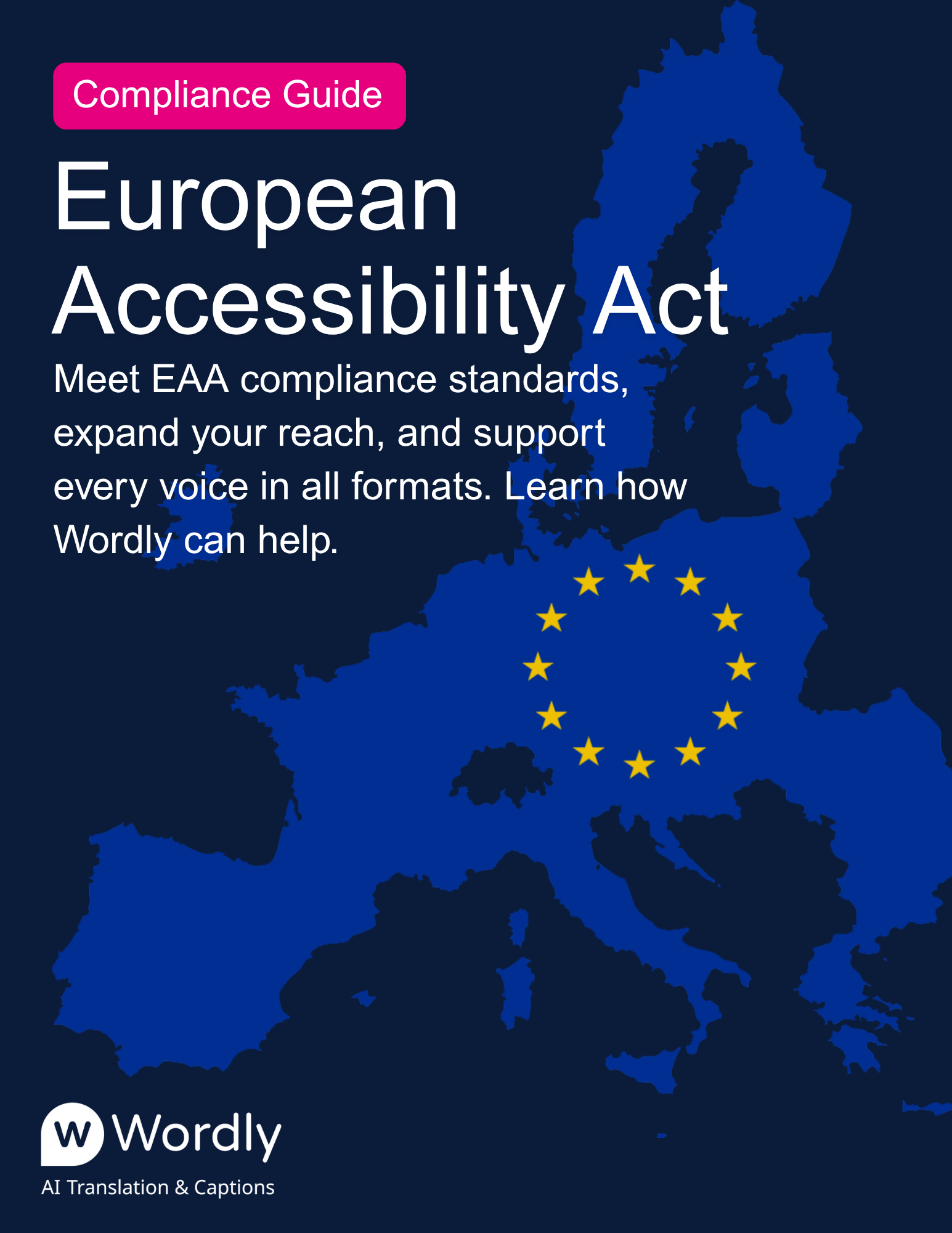Wordly es nombrada una de las empresas de software de más rápido crecimiento en los EE. UU. Descargar la guía EAA
Comprenda los requisitos de cumplimiento de la EAA y cómo la Ley Europea de Accesibilidad afecta a la accesibilidad digital en toda la UE. Prepara a tu organización para el cumplimiento.

La Ley Europea de Accesibilidad (EAA), que entró en vigor el 28 de junio de 2025, exige que los productos y servicios digitales, incluidos los sitios web, las plataformas de comercio electrónico y los medios audiovisuales, sean accesibles para todos los usuarios, incluidos los que tienen discapacidades. Esto incluye los requisitos de accesibilidad visual, auditiva, motora y cognitiva.
Las empresas que venden u ofrecen servicios en la UE deben cumplir proporcionando funciones de asistencia como subtítulos en directo, subtítulos y soporte multilingüe. La ley se ajusta a las normas de nivel AA de las WCAG 2.1 y se aplica tanto a las experiencias digitales sincrónicas como asincrónicas. Esto se aplica a una gran cantidad de industrias, tanto públicas como privadas.
Sin embargo, el cumplimiento no consiste solo en cumplir con los requisitos reglamentarios, sino también en permitir una mejor accesibilidad para todos, incluidas las personas con problemas de audición, multilingües o neurodivergentes.
Requisitos de cumplimiento de la EAA para reuniones y eventos
Quién debe cumplir
La EAA se aplica a las organizaciones del sector público y privado que ofrecen servicios en la UE. Las industrias clave incluyen:
Las pequeñas y medianas empresas (pymes) con menos de 10 empleados y menos de 2 millones de euros de facturación pueden estar exentas. Sin embargo, se sigue alentando a estas empresas a seguir las mejores prácticas de accesibilidad para seguir siendo competitivas e inclusivas.
Sanciones por no abordar el cumplimiento de la EAA
❌ Multas y acciones legales por incumplimiento.
❌ Restricciones a las operaciones comerciales en la UE.
❌ Alcance limitado y riesgo de credibilidad de la marca
La accesibilidad lingüística como factor de cumplimiento
El soporte multilingüe desempeña un papel vital en el cumplimiento de la EAA, ya que los idiomas varían según el país. No solo se trata del acceso para personas con discapacidades, sino que también ayuda a llegar a hablantes no nativos, participantes internacionales y personas en entornos auditivos difíciles. Herramientas como Wordly proporcionan traducciones y subtítulos mediante IA en tiempo real en docenas de idiomas. Esto ayuda a las organizaciones a ir más allá del cumplimiento normativo para crear eventos y experiencias digitales que sean verdaderamente inclusivos, atractivos y accesibles para todos.
El cumplimiento de la EAA para el contenido multilingüe es especialmente importante para las plataformas B2B y los sitios web de comercio electrónico globales, y la ley tiene muchas similitudes con otras regulaciones globales.
Operar en varios estados miembros de la UE hace que el cumplimiento de la EAA sea aún más complejo, ya que las empresas deben atender a un público que habla varios idiomas. Las herramientas de traducción con IA simplifican este desafío al adaptar dinámicamente el contenido a varios idiomas sin intervención manual.
Funciones como las capacidades de salida de audio de Wordly ayudan a los usuarios con discapacidad visual a interactuar con el contenido, garantizando una accesibilidad total. Confiar en soluciones avanzadas de inteligencia artificial para la traducción garantiza que las empresas no solo rasquen la superficie del cumplimiento normativo, sino que también ofrezcan experiencias verdaderamente accesibles.
La Ley Europea de Accesibilidad ya se está aplicando y entra en vigor 28 de junio de 2025. El incumplimiento puede dar lugar a sanciones, como multas, acceso restringido a los mercados de la UE y aplicación de la ley en virtud de la legislación nacional.
Los fallos de cumplimiento comunes que pueden provocar sanciones incluyen:
La adopción de soluciones de IA es una forma proactiva de ayudar a cumplir los requisitos de la EAA. Así es como tu organización puede empezar:
Con estas medidas, las empresas pueden alinear con confianza sus prácticas con la EAA y, al mismo tiempo, ofrecer experiencias excepcionales a los clientes.
La IA es más que un facilitador del cumplimiento; es una ventaja competitiva. Wordly prepara a las empresas para cumplir con algunos aspectos de los requisitos de accesibilidad, proporcionando una precisión, seguridad y velocidad incomparables.
Cómo puede ayudar Wordly:
✅ Subtítulos y subtítulos en vivo para todos.
✅ Opción de conversión de texto a voz para personas con discapacidad visual.
✅ Traducción multilingüe para cumplir con los requisitos de accesibilidad.
✅ Totalmente automatizado y sin necesidad de intérpretes humanos, lo que reduce los costos y las demoras.
✅ La integración perfecta funciona con Zoom, Microsoft Teams y otras plataformas de reuniones.
Obtenga más información sobre traducción en tiempo real.
Ya sea que estés retransmitiendo un evento corporativo, incorporando empleados de otros países o ofreciendo un servicio de atención al cliente excepcional, Wordly garantiza que tu contenido digital hable todos los idiomas y ayuda a preparar tu empresa para el futuro.
Además de ayudar a las organizaciones a cumplir con la Ley Europea de Accesibilidad, Wordly también puede ayudarte a cumplir con Canadá. Proyecto de ley 96 y EE. UU. Título II de la ADA.
Obtenga una demostración hoy para descubrir cómo Wordly ayuda a lograr el cumplimiento de la accesibilidad lingüística.